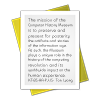Title
Carrico, Bill and Judith Estrin interviewCatalog Number
102740285Type
DocumentDescription
William “Bill” Carrico and Judith “Judy” Estrin both contributed to the early development of networking and internetworking. They developed some of the first networking and internetworking products and forged a path into this new market that many of the major computer and communications companies of the time failed to pursue.Estrin received her bachelor’s degree in Mathematics and Computer Science from UCLA and her master’s degree in Electrical Engineering from Stanford in ‘77. As a student at Stanford, she worked under Vint Cerf during the testing and implementation of the TCP protocol for the Arpanet. While at Stanford, she learned about early work on Ethernet technology in Robert Metcalfe’s class on distributed computing. Carrico graduated from Santa Clara University with a BSEE in 1972 and went to work in marketing for Fairchild Semiconductor. Their paths initially met at Stanford and then again at Zilog.
Estrin joined Zilog after graduating in ’77 and Carrico was hired in early 1979. Carrico convened two strategic product-planning meetings to focus Zilog’s product direction. One principal topic centered on how to exploit Bruce Hunt’s “Ariel” local area networking technology that became known as “the intelligent wire”. Over the next year, Carrico as business manager, and Estrin as engineering manager, transformed the Ariel project into the ZNet product, which Zilog introduced at the National Computer Conference (NCC) in June 1980 in Anaheim. ZNet was the first LAN introduced. Unfortunately, Exxon stopped funding the project, believing LANs would not be major consumers of the semiconductors being developed by Zilog.
Realizing the sentiments of Exxon management, Estrin resigned in January 1981, joining Ungermann-Bass (U-B) in a marketing position. At U-B, she was instrumental in finalizing an OEM deal with Xerox to develop an XNS compatible LAN product. Carrico, believing in the future of local area networking, found it harder and harder to stay at Zilog. So when Estrin decided to leave U-B in May 1981, Carrico resigned from Zilog and they co-founded Bridge Communications (Bridge) in June 1981.
Carrico and Estrin launched Bridge to build “bridges” to interconnect the growing number of disparate LANs technologies, but they soon realized there weren’t enough installed LANs in existence. Expanding their strategy to encompass selling LAN controllers and terminal servers brought them into direct competition with U-B. Bridge had an immediate advantage over U-B in using the 16-bit Motorola 68000 microprocessor as well as the XNS protocol software. Drawing on her past experiences with ZNet, where her team had produced a winning technology, only to see it languish without the proper sales channels, Estrin made sure they actively cultivated this emerging market of interconnecting LANs.
Bridge grew rapidly and went public in April 1986 with a valuation of $96 million. On September 30, 1987, Bridge merged with 3Com valuing the combination at $193 million. Carrico became President and COO of 3Com and Estrin became a Division General Manager.
In this interview, conducted in their home in Los Altos, CA, Estrin and Carrico discuss the early days of networking and internetworking. They capture the excitement of the interaction between leading edge research and product development as well as the social networking that took place in the early days of Silicon Valley. In person, they were fun to be with, highly informative and knowledgeable, and careful to be sure that they had their facts straight. Still newlyweds at the time of this interview, they clearly displayed the joy of being with each other.
Date
1988-06-23Contributor
| Carrico, Bill, Interviewee |
| Estrin, Judith, Interviewee |
| Pelkey, James L., Interviewer |
Publisher
Computer History MuseumPlace of Publication
Los Altos, CAExtent
29 p.Format
PDFCategory
TranscriptionSubject
Fairchild Semiconductor; Zilog, Inc.; ZNet; Bridge Communications; Network Computing Devices; Ungermann-Bass, Inc. (UB); 3Com; Bridge CommunicationsCredit
Gift of James PelkeyLot Number
X5671.2010Related Records
| 102746648 | James L. Pelkey collection : history of computer communications |


